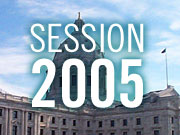Audio
Photos
More from MPR
Resources
| |||||||||||||||||||||||||||||||||||
June 15, 2005
Minnesota could stop issuing new drivers licenses, lock up state parks and highway rest stops, and possibly lay off thousands of state workers if a new budget isn't complete by the end of June. Gov. Tim Pawlenty Wednesday outlined preparations for a partial government shutdown, and lashed out at Senate Democrats, who he says are purposefully aiming for paralysis.
Democrats rebutted by offering a limited budget plan to keep government running. But there was more progress in preparing for a shutdown than there was in averting one.
St. Paul, Minn. — Gov. Pawlenty predicts that even under a partial government shutdown, "critical" services would continue to operate. That would include functions essential for health and safety, such as the State Patrol, publicly-subsidized health care programs, and food and nursing home inspections. Schools would also receive most of their aid payments.
But beyond those core programs, the governor says Minnesotans should expect plenty of headaches if the current budget stalemate leads to a shutdown.
"It is certainly going to be noticed, and it is certainly going to inconvenience a lot of people. It's certainly going to create some missed opportunities or some frustration. And it will definitely be noticed," says Pawlenty. "But we're not trying to do this as a way to scare folks or legislators. We're just trying to make sure we get good information out in advance so they can plan their lives accordingly."
Pawlenty says a shutdown would likely shutter state parks, block new drivers from getting licenses, delay environmental permits necessary for construction projects, and prevent new enrollees from accessing state health insurance for low-income workers.
Pawlenty's list differs slightly from one presented four years ago by then-Gov. Jesse Ventura. That crisis was averted at the last minute, leaving no clear precedent for determining an exact list of what stays open and what doesn't.
That will be part of a legal process initiated by Attorney General Mike Hatch. Hours before the governor outlined his shutdown preparations, Hatch asked a Ramsey County judge for an order to keep critical services funded.
Hatch, a Democrat, and Pawlenty, a Republican, have previously sparred over who had the authority to take the matter to court. They now say they're willing to work together. But Hatch also called on the governor and state lawmakers to defuse the situation by striking a budget deal.
"It's very, very important that they understand any type of government shutdown is a huge black eye for every public official in this building. Including me," said Hatch.
Pawlenty and the Republican-controlled House remain at odds with the DFL-run Senate over how to fund K-12 schools and public health care programs.
The governor has offered a 75 cents-per-pack cigarette tax to break the logjam, but Democrats say that's not enough to fully meet the state's needs. They've proposed a new income tax bracket for the state's wealthiest households. Pawlenty says Senate leaders are attempting to force a shutdown for political advantage.
"I think they believe that a shutdown will cause a sense of cynical reaction that will benefit them. And I hope the public sees through that, and sends our friends the Senate Democrats a strong message," Pawlenty said.
It appears that neither side is getting the message. At an earlier meeting of top lawmakers from both parties, the two sides mainly argued in circles, repeating familiar criticisms and making little forward progress.
DFL leaders say the talk of shutdown is premature and unnecessary. Assistant Senate Majority Leader Ann Rest of New Hope says if a final deal isn't struck by July 1, lawmakers and the governor ought to approve a temporary funding bill that keeps the state more or less at current funding levels. That way, she says, the debate can continue without being rushed by the threat of a shutdown.
"We believe that that's a fairly simple, straightfoward approach to our dilemma at this point. We don't believe anything needs to be decided in a panic," said Rest. "And we can act in a -- continue to act -- in a very deliberative way as we solve our budget dilemmas."
But Pawlenty is opposed to current funding levels, saying they're too low for K-12 schools and too high for health and human services. He said he would accept a temporary funding measure for state parks and state parks only.






